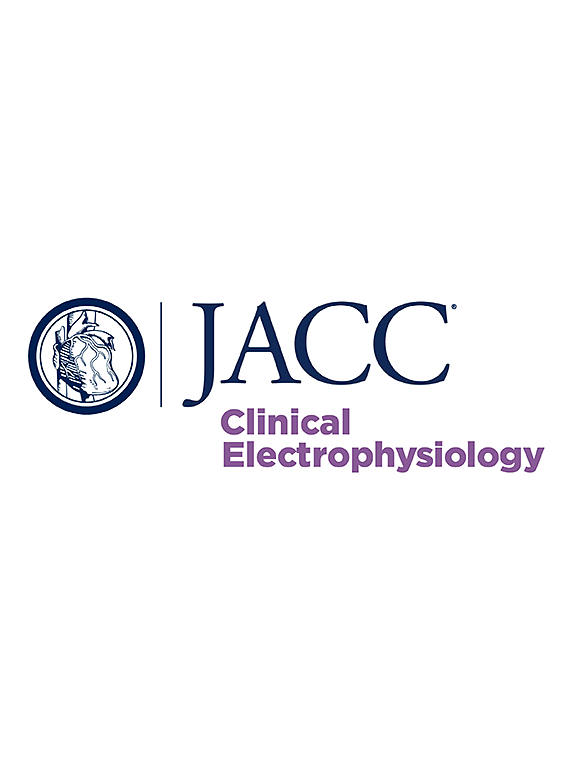阵发性心房颤动和复发性心房心律失常消融后过早心室复合体:钦佩亚分析。
IF 7.7
1区 医学
Q1 CARDIAC & CARDIOVASCULAR SYSTEMS
引用次数: 0
摘要
背景:早发心室复合体(室性早搏)已被报道为在普通人群中独立预测房颤的发生。导管消融后室性早搏对阵发性心房颤动(PAF)预后的重要性尚不清楚。目的:在接受导管消融治疗PAF的患者中,我们评估消融后室性早搏是否会影响复发风险。方法:我们分析了美国食品和药物管理局(fda)的一项多中心单臂试验(NCT05293639)中PAF患者使用可变回路导管进行脉冲场消融治疗管理的安全性和有效性评估的数据。在第1 - 5个月期间每周收集≥60秒的超声监测,在第6 - 12个月期间每月收集一次,并由核心实验室评估室性心动过速。拟合消融后早期室性早搏(1 ~ 180天)与消融后(91 ~ 365天)心房心律失常复发关系的Logistic回归模型。结果:在361例患者中,135例(37.5%)患者在180天前出现消融后室性早搏。在多变量模型中,与消融后无室性早搏的患者相比,有室性早搏的患者心房心律失常复发的风险增加了一倍(OR: 2.1;95% ci: 1.2-3.5;P = 0.006)。在另一项研究中,使用非常高功率、短时间射频消融治疗PAF的分析表明,在一个较小的队列中(N = 261),早期室性早搏再次与更高的复发风险相关(OR: 2.3;95% ci: 1.2-4.6;P = 0.015)。结论:房颤导管消融后前6个月房颤患者复发性心律失常的风险较高。室性早搏本身是否会引发心房心律失常,或者两者的共同潜在机制是否都会引发心房心律失常,目前仍不确定。本文章由计算机程序翻译,如有差异,请以英文原文为准。
Premature Ventricular Complexes After Ablation for Paroxysmal Atrial Fibrillation and Recurrent Atrial Arrhythmias
Background
Premature ventricular complexes (PVCs) have been reported to independently predict incident atrial fibrillation in the general population. The prognostic importance of PVCs after catheter ablation for paroxysmal atrial fibrillation (PAF) is unknown.
Objectives
In patients undergoing catheter ablation for PAF, we assessed whether postablation PVCs influence the risk for recurrence.
Methods
We analyzed data from admIRE (Assessment of Safety and Effectiveness in Treatment Management of Atrial Fibrillation With the Biosense-Webster Irreversible Electroporation Ablation System; NCT05293639), a multicenter single-arm Food and Drug Administration trial of PAF patients undergoing pulsed field ablation with a variable-loop catheter. Transtelephonic monitoring ≥60 seconds was collected weekly during months 1 to 5, monthly during months 6 to 12, and for symptomatic events, and PVCs were assessed by a core lab. Logistic regression models of the relationship between early postablation PVCs (days 1-180) and postblanking (days 91-365) recurrence of atrial arrhythmia were fitted.
Results
Among 361 patients from admIRE, 135 (37.5%) patients had postablation PVCs noted prior to day 180. In the multivariable model, as compared with patients without postablation PVCs, those with PVCs had double the risk of atrial arrhythmia recurrence (OR: 2.1; 95% CI: 1.2-3.5; P = 0.006). An additional analysis in a second study that used very high-power, short-duration radiofrequency ablation for PAF demonstrated in a smaller cohort (N = 261), early PVCs were again associated with higher risk of recurrence (OR: 2.3; 95% CI: 1.2-4.6; P = 0.015).
Conclusions
Patients with PVCs in the first 6 months after catheter ablation for PAF are at higher risk for recurrent atrial arrhythmia. Whether PVCs themselves trigger atrial arrhythmias, or common underlying mechanisms trigger both, remains uncertain.
求助全文
通过发布文献求助,成功后即可免费获取论文全文。
去求助
来源期刊

JACC. Clinical electrophysiology
CARDIAC & CARDIOVASCULAR SYSTEMS-
CiteScore
10.30
自引率
5.70%
发文量
250
期刊介绍:
JACC: Clinical Electrophysiology is one of a family of specialist journals launched by the renowned Journal of the American College of Cardiology (JACC). It encompasses all aspects of the epidemiology, pathogenesis, diagnosis and treatment of cardiac arrhythmias. Submissions of original research and state-of-the-art reviews from cardiology, cardiovascular surgery, neurology, outcomes research, and related fields are encouraged. Experimental and preclinical work that directly relates to diagnostic or therapeutic interventions are also encouraged. In general, case reports will not be considered for publication.
 求助内容:
求助内容: 应助结果提醒方式:
应助结果提醒方式:


